
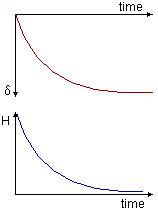 The sudden application
of a load to a saturated soil produces an immediate increase in porewater
pressure. Over time, the excess porewater pressure will dissipate, the
effective stress in the soil will increase and settlement will increase.
Since shear strength is related to effective stress, it may be necessary
to control the rate of construction to avoid a shear failure. This was
the case, for example, when approach embankments were constructed on soft
alluvium, for the bridge which carried the M180 motorway over the River
Trent near Scunthorpe. The rate at which the excess water pressure dissipates,
and settlement occurs, depends on the permeability of the soil, the amount
of water to be expelled and the distance the water must travel.
The sudden application
of a load to a saturated soil produces an immediate increase in porewater
pressure. Over time, the excess porewater pressure will dissipate, the
effective stress in the soil will increase and settlement will increase.
Since shear strength is related to effective stress, it may be necessary
to control the rate of construction to avoid a shear failure. This was
the case, for example, when approach embankments were constructed on soft
alluvium, for the bridge which carried the M180 motorway over the River
Trent near Scunthorpe. The rate at which the excess water pressure dissipates,
and settlement occurs, depends on the permeability of the soil, the amount
of water to be expelled and the distance the water must travel.

Shear strengthCollapse will occur if the shear stress along a potential failure surface exceeds the shear strength of the soil. Shear strength depends on the effective normal stress, which depends on the porewater pressure. Undrained loading causes an increase in porewater pressure equal to the change in the total normal stress so that there is no increase in strength to match the change in the shear stress.The shear strength can be increased either by decreasing the water pressure or reducing the void ratio of the soil to produce a peak strength which exceeds the critical shear stress. |
 |
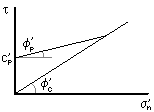 |
Thin horizontal layers of coarse-grained soil in a mass of fine-grained
soil may dramatically increase the horizontal permeability while having
little effect on the vertical permeability. It is possible to increase
the drainage rate without changing the permeability of the bulk of the
soil by introducing layer drains (sandwicks) or fracturing the soil. The
most effective way to reduce seepage into an excavation, through or under
a dam, or away from contaminated ground is to create a low permeability
zone perpendicular to the direction of flow.
| Pumping water out of the ground will cause a local lowering of the ground water level and a decrease in water pressure. Both will return to their natural state when pumping stops. The rate of drawdown and the radius of influence depend on the permeability of the soil: Low permeability implies slow drawdown and large radius. Decreasing the water pressure increases the effective stress, which increases the shear strength and causes settlement. | 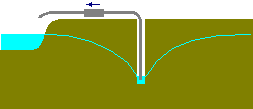 |
| The introduction of a grid of vertical drains, connected by layer of highly permeable soil, reduces the distance water has to travel through the natural soil and facilitates horizontal flow. This limits the excess water pressure generated during and after construction and increases the rate of settlement. | 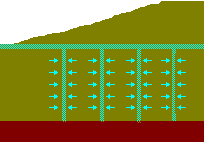 |
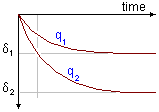 Settlement due
to an applied pressure occurs over a period of time. A proportion of the
final settlement can be achieved prior to construction by pre-loading the
soil. The larger the pre-load, the less time it will take to achieve the
final settlement. Pre-consolidating the ground in this way tends to be
an expensive solution compared with the use of piles to support localised
loads such as columns. Pre-consolidation may be a cost-effective way of
reducing the settlement due to lightly distributed loads from roads or
warehouse or supermarket floors provided that material is readily available
to provide the pre-loading. Pre-consolidation is normally designed to take
6 - 9 months.
Settlement due
to an applied pressure occurs over a period of time. A proportion of the
final settlement can be achieved prior to construction by pre-loading the
soil. The larger the pre-load, the less time it will take to achieve the
final settlement. Pre-consolidating the ground in this way tends to be
an expensive solution compared with the use of piles to support localised
loads such as columns. Pre-consolidation may be a cost-effective way of
reducing the settlement due to lightly distributed loads from roads or
warehouse or supermarket floors provided that material is readily available
to provide the pre-loading. Pre-consolidation is normally designed to take
6 - 9 months.

 Dynamic compaction
involves lifting and dropping a heavy weight several times in one place.
The process is repeated on a grid pattern across the site. Trials in the
UK indicate that the masses in the range 5 to 10 tonnes and drops in the
range 5 to 10m are effective for compacting loose sand but not clay. Masses
up to 190 tonnes and drops of 25m are used by TLM (Technique Louis Ménard)
in France. Such heavy compaction causes fractures through which water can
flow. This, according to the proponents of the system, enables fine-grained
soils to be compacted. Heavy compaction tends to annoy the neighbours,
which limits its use in built-up areas.
Dynamic compaction
involves lifting and dropping a heavy weight several times in one place.
The process is repeated on a grid pattern across the site. Trials in the
UK indicate that the masses in the range 5 to 10 tonnes and drops in the
range 5 to 10m are effective for compacting loose sand but not clay. Masses
up to 190 tonnes and drops of 25m are used by TLM (Technique Louis Ménard)
in France. Such heavy compaction causes fractures through which water can
flow. This, according to the proponents of the system, enables fine-grained
soils to be compacted. Heavy compaction tends to annoy the neighbours,
which limits its use in built-up areas.
compactive energy per blow = m.g.h
where m = mass, g = gravitational constant, h = drop.estimated depth of compaction = n.Ö(m.h)
where n is an empirical constant between 0.3 and 1 depending on the grain size distribution and degree of saturation (0.5-1 for sands, 0.3-0.5 for silts and clayey soils).
 Both vibro-compaction
and vibro-replacement use a vibrating poker to make a hole in the ground.
Soil is displaced sideways, not removed from the ground.
Both vibro-compaction
and vibro-replacement use a vibrating poker to make a hole in the ground.
Soil is displaced sideways, not removed from the ground.
vibro-compaction
in coarse-grained soils the poker may be removed slowly while still
vibrating. This causes the sides of the hole to collapse and results in
a depression in the ground surface.
vibro-replacement
in fine-grained soils it is usual to fill the hole with coarse aggregate
(up to 50mm). The poker may be used to compact the stone column in layers.
A typical column might be 5m deep and 500mm diameter. A line of columns
at say 3m centres can be used to support a reinforced concrete ground beam
effectively producing a piled foundation.
Grout injection into fractured rock which forms the foundation of a dam is possibly the oldest and best known application. Grout injection has been used successfully to strengthen and reduce permeability of soil around a basement excavation below the water table. It has also been used to control the settlement of structures adjacent to tunnel excavations in London: predicted settlements of 60mm, which would have caused extensive damage to old buildings, were limited to 10mm.
Silty soils with high water contents are unsuitable for embankment construction
in their natural state because they are difficult to compact. They can
be improved by mixing hydrated lime with the soil.